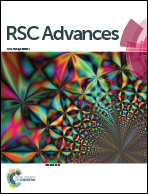Fluorescent topographic nanopatterns by fluorophore-functionalized diblock copolymers†
Abstract
We demonstrated the fabrication of fluorophore-functionalized nanopatterns with topographic features. To obtain fluorescent nanopatterns, diblock copolymers having fluorophores in one of the blocks were synthesized by the reversible addition fragmentation chain transfer polymerization and were annealed by solvent vapor, resulting in perpendicular or parallel cylindrical nanopatterns functionalized with fluorophores, depending on the annealing solvent. Then, by etching one of the copolymer blocks, we were able to produce fluorescent topographic nanopatterns. Furthermore, Au nanorods selectively loaded in the nanometer-sized valley of the pattern effectively altered the fluorescence of the topographic nanopattern.


 Please wait while we load your content...
Please wait while we load your content...